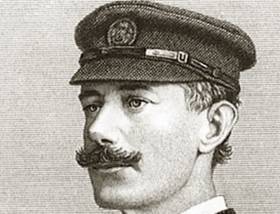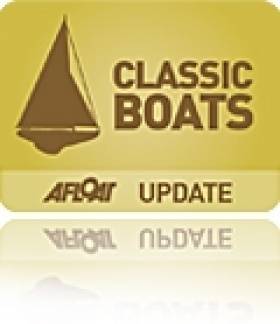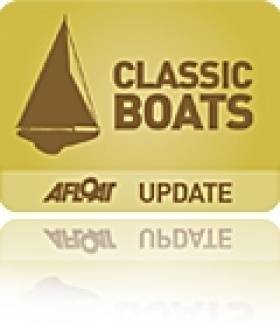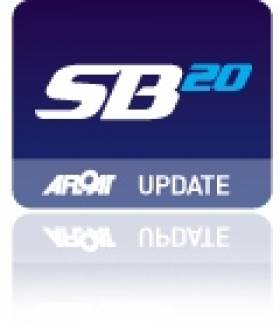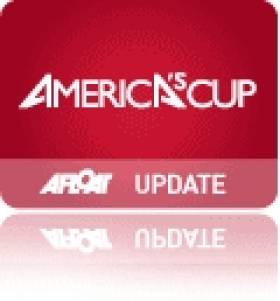Displaying items by tag: Royal Yacht Squadron
Royal Cork Place Fifth In Second Global Team Racing Regatta
A team from Royal Cork Yacht Club made a strong showing in Cowes at the second annual Global Team Racing Regatta over the weekend.
Extreme conditions beset the 12-team fleet hosted by the Royal Yacht Squadron, all racing in matched J70s that faced winds rarely less than 18 knots.
Each day saw a similar pattern of fresh breeze mounting to gale force by early afternoon resulting in racing being abandoned.
Despite this, the race management team delivered a full round robin that was fought hard to the very end, with a thrilling climax that saw St Francis Yacht Club from San Francisco awarded the title after two late errors by last year’s winners, the contingent from Royal Thames.
The Global Team Racing Regatta, of which the Royal Cork was a part in its debut last year, will move to Italy for its third edition in 2020 where it will be hosted by the Yacht Club Costa Smeralda.
Final Standings
- St Francis Yacht Club (USA)
- Royal Thames Yacht Club (GBR)
- New York Yacht Club (USA)
- Newport Harbor Yacht Club (USA)
- Royal Cork Yacht Club (IRL)
- Dutch Match and Team Race Association
- Royal Yacht Squadron (GBR)
- Bayerischer Yacht Club (GER)
- Sorrento Sailing Couta Boat Club (AUS)
- Yacht Club Argentino (ARG)
- Japanese Sailing Federation (JAP)
- Royal Bombay Yacht Club (IND)
Controversial Irish Challenger Inducted Into America’s Cup 'Hall Of Fame' – After 121 Years
The two America’s Cup Challenges made through the Royal Yacht Squadron by Lord Dunraven of Adare in County Limerick in 1893 and 1895 both had elements of controversy writes W M Nixon. And such serious ill-feeling emerged after his challenge of 1895 that Dunraven was subsequently relieved of his Honorary Membership of the defending New York Yacht Club, an extreme and unprecedented step which led to international diplomatic moves to smooth the waters between the UK and the US.
Dunraven – who had been introduced to sailing by the great John Jameson aboard the famous racing cutter Irex in Dublin Bay in the 1880s – made his challenges with large cutters designed by the renowned G L Watson. And the 1893 matter of potential friction was successfully resolved when Dunraven’s contention that there should not be an inshore course option was successfully upheld in order to ensure truer wind conditions.
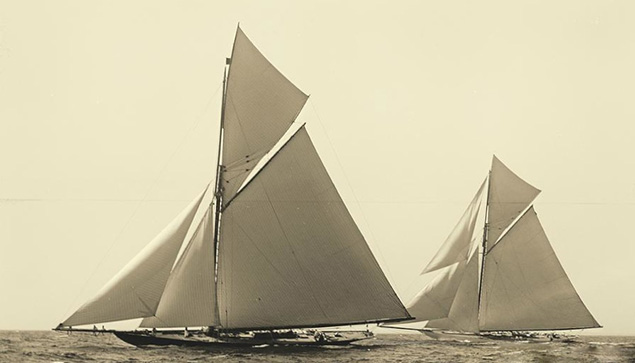 The G L Watson-designed Valkyrie II (left) racing against Vigilant in the 1893 America’s Cup. Valkyrie II was a near-sister of the Royal cutter Britannia which was built the same year
The G L Watson-designed Valkyrie II (left) racing against Vigilant in the 1893 America’s Cup. Valkyrie II was a near-sister of the Royal cutter Britannia which was built the same year
But with the second challenge by the 129ft Valkyrie III in 1895 at New York harbour, he became so incensed by what he felt was the intrusion of the huge spectator fleet into the racing area that he made a formal complaint about about it. And after Valkyrie III was held responsible for minor collision in the second race for which which he tended to blame the spectator fleet, he withdrew from the series with further grievances.
Both the Dunraven challenges ended in defeat, though he was only beaten by 40 seconds in the final race of 1893, with Valkyrie II starting to perform to her true potential. But they had successfully raised the standard of yacht raced in the America’s Cup to a much higher technical level. However, the 1895 effort ended not only in defeat, but with a high level of acrimony which lasted until this year, with the Dunraven challenges almost air-brushed out of some histories of the America’s Cup.
Yet as time has passed a greater realization has developed of Dunraven’s other achievements, for he was a man of many talents – for instance, he successfully co-chaired the Conference which brought Land Act settlement to Ireland in 1903. And some historians of the America’s Cup feel that in the hectic world of the 1890s, the American defenders may have come down a little too heavily on a Challenger who became very isolated in his efforts in 1895 after he had begun to look like a contender in 1893.
Certainly when the next series was held in 1899 – with Sir Thomas Lipton challenging through the Royal Ulster Yacht Cub with Shamrock I – the race area was rigorously patrolled by the US Navy to keep spectator vessels well away. And in later stagings of this pinnacle of world sailing, cognisance was also taken of Dunraven’s feeling that the course should be moved further away from the adverse effects of land upon wind behaviour.
So in this year of 2016, a year in which America seems to be increasingly mired with internal political controversy, it’s good to know that during the summer Windham Thomas Wyndham-Quin, 4th Earl of Dunraven (1841-1926) was finally inducted into the America’s Cup Hall of Fame for his contribution to course-setting protocols, and his pioneering of the Golden Era when huge yet technically-advanced yachts raced for the Holy Grail of international sailing.
Howth's Bedrock skippered by Richard Burrows was the sole Irish Etchells competing at a star studded Sir Kenneth Preston Trophy fleet at the Royal Yacht Squadron at the weekend. The HYC boat finished 19th from 28 in a fleet that included former Volvo Round the World racer Lawrie Smith. The regatta attracted one of the largest fleets of Etchells seen in the Solent for many years. Bolstered by the forthcoming 2016 Etchells World Championship, to be held in the Solent 31 August – 10 September.
The Sir Kenneth Preston Trophy was first competed for in 1995, after Sir Kenneth Preston, who had led the British sailing team in the 1960 Olympics, presented it to the Royal Yacht Squadron shortly prior to his death. Sir Kenneth wished that the trophy be competed for by a deserving one design fleet that had the spirit of one design and involves young sailors. It is a feather in the cap for the Cowes Etchells fleet to have retained it for so many years.
28 teams with sailors from Australia, Great Britain, Hong Kong and the United States of America, raced for the Sir Kenneth Preston Trophy. Three Royal London Etchells Youth Academy Teams took part, skippered by Anna Watkins, Owen Bannerman and Martin Evans.
The eight race programme over three days produced thrilling racing, with 11 teams achieving podium results. Peter Duncan was the winner of the Sir Kenneth Preston Trophy, Ante Razmilovic was second with Lawrie Smith third.
Commodore of the America Yacht Club, Peter Duncan and Tom Blackwell have campaigned Etchells for many years with top finishes including second, third, fourth, and fifth in world championships. Both grew up sailing in the JAYC (Junior American Yacht Club) program. Jud Smith, a Sonar, Mumm30 and Etchells World Champion, has been sailing with the team since 2013.
“We found the racing very tight with a solid mix of local and visitors trying to get ready for the Worlds.” commented Peter Duncan. “Throughout the regatta we had a lot of boats arriving at the weather mark together and there were some exciting leeward gate roundings. Cowes is a very interesting place to sail, as you not only have to be on your toes for shifts in the breeze, the current has to minded at all times. We saw a bit of everything this past weekend, which made it a great warm up event to the Worlds. In 2007 and since, we have not sailed in the breeze direction we had on Saturday so that was good to experience.
Our stay as always in Cowes was wonderful as there are so many fun places to go. The Royal Yacht Squadron did an outstanding job running the races in the varied conditions and especially setting up the starting lines. As always, David Franks and team did a wonderful job on the social side of the event with the dinner event at RYS being awesome. Not too many of us from overseas have ever been there so what a treat.”
David Franks, Cowes Etchells fleet captain. "We have been delighted that the interest in the Cowes Etchells Fleet continues to grow."
David Franks, the Cowes Etchells fleet captain commented: "We have been delighted that the interest in the Cowes Etchells Fleet continues to grow with record numbers competing for the Sir Kenneth Preston Trophy. This is the 22nd year that this Trophy has been awarded by the Royal Yacht Squadron; they ran eight excellent races and provided a superb supper on the Platform in the Castle for 94 competitors and their guests. Wonderful racing; wonderful food."
The Saida Cup 11-12 June, organised by the Royal Thames Yacht Club, is the next event in a busy season for the Cowes Etchells Fleet. The Etchells UK National Championship, organised by the Royal London Yacht Club, from 24-26 June, is an Etchells World Championship qualifying event.
Full results of the Sir Kenneth Preston Trophy are downloadable below.
Rick Tomlinson 2016 Sailing Calendar Is Ideal Christmas Gift
The 28th edition of the highly acclaimed Rick Tomlinson Portfolio calendar is now available directly from the Afloat.ie marketplace site HERE. The ideal Christmas gift for the sailor in your life features 12 spectacular images from recent assignments around the world.
This year's pictures include action from The Volvo Ocean Race at Cape Horn, the Royal Yacht Squadron Bicentenary Regatta, Sir Ben Ainslie’s Americas Cup challenge, sailing in Greenland, plus other action and art from the international racing circuit.
Action and art has always been Rick’s style, “Each picture will hang on the wall for a month and offer the viewer something that perhaps they didn't see on the first look” says Rick, “my particular favourite this year is the shot of Brunel off Cape Horn.”
Rick has raced in 4 Whitbread Round the World Races, on Drum, The Card, Intrum Justitia and Team EF. Photographs taken onboard Drum started his career, becoming one of the most highly acclaimed marine photographers in the world. High profile projects include the Volvo Ocean Race, Americas Cup, and many SuperYacht commissions. He was recently the Official photographer for Team SCA.
Rick works from his gallery in Cowes - Isle of Wight, and travels the world on assignments for the worlds leading events and yachts.
In late June, one of sailing's most celebrated yachts will attempt to retrace the steps of her first, and most significant, victory. The 52-foot yawl Dorade, owned by Pam Levy and Matt Brooks (Tiburon, Calif.), will join 40 other boats competing in the Transatlantic Race 2015, which starts off Newport, R.I., and finishes off the southwestern coast of England. The race is organized by the Royal Yacht Squadron, the New York Yacht Club, the Royal Ocean Racing Club and the Storm Trysail Club.
Dorade, the seventh design from the Sparkman & Stephens design shop, was barely a year old when Olin and Rod Stephens and a crew of five sailors, including their father, started the 1931 Transatlantic Race off Newport, R.I., bound for Plymouth, England, 2,800 miles away. The trip took just over 17 days. Dorade was the first boat to finish and the race's overall champion on corrected time.
For the Stephens brothers, it was a transformative moment: in the coming years, they would each take on primary roles in the development of the sport. Dorade would make her own wake as well, stringing together an impressive, unparalleled for the time, series of victories on the East and West Coasts of the United States and in Europe.
After a series of significant re-fits, the boat was returned to original condition a few years ago by Levy and Brooks. Perfect for installation in a museum, many said, or for civilized day racing on the classic yacht circuit. But Levy and Brooks had other plans, namely to take the grand dame of ocean racing and repeat all of the races it won in the 1930s, including the Transatlantic Race, Newport Bermuda, Transpac and Rolex Fastnet.
"Everyone said we were proposing something that wasn't even in the realm of possibility," says Brooks of Dorade's four-race "Return to Blue Water" campaign. "Now we're coming up to the last two races—the Transatlantic Race 2015 and the Rolex Fastnet Race—and no one is questioning that the boat can do this." (Two years ago, Dorade won overall, corrected-time honors in the Transpac Race, beating a host of the latest carbon-fiber rockets; in the 2014 Newport Bermuda Race, she took first in her class under IRC.)
"Olin and Rod designed one hell of a boat," says Brooks. "I haven't met anyone who has sailed on her who doesn't learn to love her and trust her. She's very strong, very dependable; she just needs to be treated right. With wood boats, you're always in refit mode. But we're racing and sailing this boat 10,000 miles a year and she absolutely responds to that."
Winning silver with this historic yacht requires a comprehensive commitment. Brooks, Levy and their team are constantly maintaining and refining the yacht. This past winter, says Brooks, getting the bottom as smooth as possible and improving sail design were two areas of focus. Sailing the boat also requires a specific touch.
"If you are trying to muscle the boat into submission at the helm it is never going to happen," says Levy. "It will win. Having a balanced helm is critical."
For the Transatlantic Race 2015, Brooks and Levy have set as their first goal to beat the 17 days, one hour and 14 minutes it took Dorade to sail the course in 1931. Modern technology, including synthetic sail fabric, should give this year's team an edge; however, the course in 2015 is likely to be quite a bit longer than it was in 1931 due to an extreme number of icebergs in the Grand Banks of Newfoundland. The fleet will be required to sail east for a while before turning north for the Great Circle Route, which takes advantage of the earth's slightly oval shape to shave critical miles off the passage between the United States and Europe.
Whether or not they can match the boat's pace in 1931, Brooks and Levy couldn't be more excited about the prospect of this legendary yacht coming full circle to its first significant accomplishment.
"Of all the races we've done, the Transatlantic Race is the one that makes our heart go pitter patter, because it was Olin and Rod's first big victory, and it's what launched them in business in yacht design," says Levy. "We know from talking to Olin's family and from what he has written that he had a real affection for the boat. It gives us a lot of pleasure to do well with her."
Royal Yacht Squadron to Hold Bicentenary Regatta in Cowes
#rys – The promise of a spectacle of timeless classic versus cutting edge modern is emerging early in the year as the entries for the Royal Yacht Squadron's Bicentenary start to lay down the gauntlet for the summer of sailing in England's Solent in the last week of July.
Three majestic J-Class Yachts, Velsheda, Ranger and Lionheart (pictured), will line up alongside other historic legends including the 48ft Tomahawk built in 1938 and 52ft Dorade, built in 1929. Both are Sparkman and Stephens designs. From the breathtaking schooner Eleonora at 160ft to the two 8 metre yachts Helen and Enchantement born 1936 and 1923 respectively, the event has been a magnet for the most immaculate and competitive classics in Europe and beyond. Several, including Dorade herself, are racing across the Atlantic from Newport, Rhode Island, to take part in this Royal Yacht Squadron's 200 years celebration.
Entries to date include the mighty 120ft–Briand designed sloop Bristolian, mini-maxi Jethou and many well known names in the performance IRC fleets including Ker 46 Tonnere of Breskens, Elan 40 Flair, TP 52 Gladiator, and Grand Soleil 43 Quokka.
The Swan class will be represented too - entries include Swan 57 Noonmark VI, which will also be taking part in the Transatlantic Race, and Swan 44 Rosy Pelican.
More from the Squadron here
Irish Sailing Clubs Lose Out As Royal Yacht Squadron Hosts 2017 SB20 World Championships
#sb20 – The SB20 keelboat class will hold its 2017 World Championships at the prestigious Royal Yacht Squadron in Cowes.
It's somewhat disappointing news for Irish sportsboat sailing following a competitive tender process from five international sailing clubs including three Irish ones from Cork, Galway and Ulster.
The SB20 World Council voted for the RYS to host the championships. Event dates will be confirmed early in 2015.
As Afloat.ie previously reported last August, Irish SB20 Class President Justin Burke had been urging Irish clubs to get behind the sportsboat bid and bring the Championships here for a second time.
Ireland previously hosted the inaugural worlds – when the class was known as the SB3 – in 2009 at the National Yacht Club in Dun Laoghaire attracting a massive fleet of 163 boats divided into two flights.
Ed Russo, President of the SB20 World Council, commented: "We are excited about the opportunity of the Royal Yacht Squadron in Cowes hosting the 2017 SB20 Worlds. The Solent is where the first SB20 fleet began and we expect a significant number of participants from the 13 fleets around the world to return to the founding waters for this event."
The Royal Yacht Squadron is one of the most prestigious yacht clubs in the world, the host club of the very first America's Cup race (held around the Isle of Wight in 1851), and founder of the famous Cowes Week regatta. With its spectacular canon start-line at Cowes Castle, the Squadron hosts top level racing events on the Solent waters each year.
Rear Commodore (Yachting) Jonathan Perry commented: "The Royal Yacht Squadron is delighted to have been selected to host the SB20 World Championships in 2017. The Solent provides challenging sailing conditions for this truly international class, which we look forward to welcoming to Cowes."
The SB20 class is an international one-design keelboat sailed by three or four people which offers incredibly close 'level' racing, attracting both amateur and professional sailors of all ages. It is a familiar sight on the Solent, and provides superb value for money with class starts and one-design fleets at major regattas such as Aberdeen Asset Management Cowes Week, as well as its own class championships and Grand Slam circuit.
The SB20 class has over 750 boats sailing worldwide with established fleets in the UK, Ireland, France, Italy, Portugal, Netherlands, Belgium, Germany, Ukraine, Russia, Dubai, Singapore and Australia, and regularly attracts fleets of over 100 boats for international events. A global fleet is expected for the 2017 World Championships as well as a strong UK entry.
The SB20 will hold its 2015 World Championships at Torbole, on Lake Garda, Italy and in 2016 in Cascais, Portugal, giving the fleet three superb venues for the next three overall World Championship contests, which also include Youth, Masters and Ladies titles.
Ben Ainslie's British Challenge Accepted for the 35th America's Cup
The British Royal Yacht Squadron Racing (RYSR) has had its challenge accepted by the America's Cup defender, the Golden Gate Yacht Club of San Francisco. RYSR is the affiliate club of the Royal Yacht Squadron and the challenging club for Ben Ainslie Racing (BAR), now the official British entry for the 35th America's Cup in 2017.
The Golden Gate Yacht Club (GGYC), having won the 34th America's Cup, holds the America's Cup in accordance with the terms of a Deed of Gift dated 24 October 1887 and will be hosting the event in three years' time, although the location is yet to be confirmed, being either San Diego or Bermuda.
RYSR submitted its Notice of Challenge to the GGYC during the two-month open entry period which closed on Friday 8th August. The entry has now been formally accepted.
Each team that challenges for the America's Cup is required to do so through a host club. The America's Cup started its long history at the Royal Yacht Squadron when the schooner America beat a fleet of British racing yachts to the finish line there on 22 August 1851, watched by Queen Victoria.
"We are delighted that Ben Ainslie Racing, led by Sir Ben, has asked Royal Yacht Squadron Racing to challenge on his behalf and are sure that, if anyone can bring the Cup back to its original home, he and his excellent BAR team can," commented Simon van der Byl, CEO of RYSR.
The Royal Yacht Squadron Launches Biscay Race
Organised by the Royal Yacht Squadron, Cowes, England, with the assistance of Real Club Náutico de Sanxenxo in Northern Spain, the Biscay Race will start from the Royal Yacht Squadron (RYS) line at midday on Sunday 11th September and finish off the yacht club in Sanxenxo. The Notice of Race and Entry Form are now available online at: www.rys.org.uk
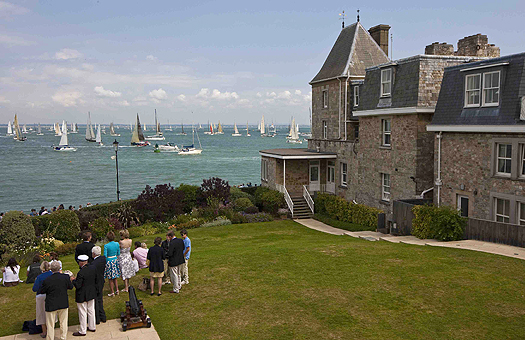
RYS Commodore Yachting, David Aisher explains the RYS' foray into offshore racing: "When the New York Yacht Club first announced that they wished to join with RYS, RORC and the Storm Trysail Club to form the AORS, the Royal Yacht Squadron was the only club that did not have a race that was a part of this new circuit. On the East side of the Atlantic, the RORC was the Organising Authority for the Rolex Fastnet and was also a part of the Rolex Middle Sea Race. Between the two races was a large gap in the sailing calendar that we felt was an ideal opportunity for the RYS to run its first offshore race. The RYS has for many years been organising some of the best inshore regattas in the UK and for us, to be a true part of this new AORS event, we needed to show that we could also run a first rate offshore event as well. This is not an attempt to compete with the RORC or any other of the excellent offshore clubs, but is our contribution to this exciting racing series."
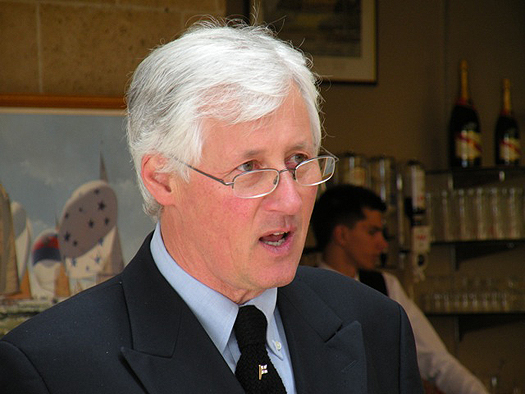
Top Boats to Compete
Interest has already been received from two yachts who recently competed in the Transatlantic Race 2011, the fourth race in the Atlantic Ocean Racing Series: George David's Rambler 100 (USA) who set the benchmark for the new transatlantic route from Newport, Rhode Island (USA) to The Lizard (UK) and British Soldier, the Army Sailing Association's A40. Both are going on to compete in the classic offshore race, the Rolex Fastnet Race. Interest has also been received from Alex Thomson's IMOCA 60, Hugo Boss (GBR), whose sights are set on the Transat Jacques Vabre later this year. A number of the other TR2011 boats are also expected to take part.
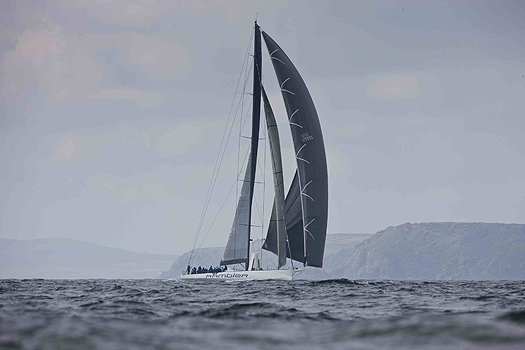
Rambler 100 - Photo: Mark Lloyd
Feeder Race
Racing for the Biscay Armada Dish, The Biscay Race may also act as a feeder race for competitors in the Rolex Middle Sea Race (22nd October); those wishing to sail to the Mediterranean and could also attract yachts taking part in World Cruising Clubs' Atlantic Rally for Cruisers (ARC) which sets off from Las Palmas, Gran Canaria for St Lucia on 20th November.
As an added incentive, The Real Club Náutico de Sanxenxo is offering free berthing for a week to competitors on completion of the race and a prize giving dinner will be held by the kind invitation of club on Friday 16th September for all crews.
Two Irish Boats for Transatlantic Race 2011
Two big names in Irish offshore racing are among the 30-boat fleet preparing for the Transatlantic Race 2011 (TR 2011) this June. Last night the organisers, the Royal Yacht Squadron, New York Yacht Club, Royal Ocean Racing Club and Storm Trysail Club, extended the deadline to enter the Race to March 31, 2011.
Adrian Lee's Cookson 50 from Dublin Bay and the Limerick Volvo 70 skippered by Ger O' Rourke's both make the entry list although the Shannon estuary's Chieftain is described only as a 'provisional' entry. For Entry list click HERE.
With the Transatlantic fleet now over 30 entries and many new inquiries following the success of the RORC Caribbean 600 - part of the companion Atlantic Ocean Racing Series - the organisers encourage those interested to enter the TR 2011 as soon as possible to secure a spot since the Notice of Race notes a maximum of 50 yachts for the race.
The TR 2011 will cover 2,975 miles from Newport, R.I., to the Lizard in England. The focus of pre-race activities will be the New York Yacht Club's Harbour Court clubhouse in Newport, R.I. There will be three staggered starts from June 26 to July 3. The awards ceremony on August 9th and other post-race activities will be held at the Castle, the home of the Royal Yacht Squadron in Cowes, England.
The fleet will include IRC Racing, IRC Racer/Cruiser, Classic and Open divisions with a minimum length overall (LOA) of 40 feet and no maximum. Competition is building within several segments of the diverse fleet, notably the 100' and up range which includes Sojana, Rambler 100, ICAP Leopard, and Maltese Falcon.
Tight racing is also expected in other classes and divisions, such as yachts in the under 50' range in IRC Racing and IRC Racer/Cruiser including the Class 40s - Concise 2, Dragon, and Kamoa'e, the Rogers 46s - Shakti and Varuna, as well as British Soldier ASA, Jacqueline IV, Sasha, Dawn Star, and Carina. For a complete list of entries click here.
All race documents are available HERE.
The TR 2011 is the centerpiece of the Atlantic Ocean Racing Series (AORS), and is organized in concert with the following clubs: Royal Malta Yacht Club, Annapolis Yacht Club, Ida Lewis Yacht Club, Montego Bay Yacht Club, Naval Academy Sailing Squadron, Jamaica Yachting Association, Antigua Yacht Club and Real Club Nautico de Sanxenxo.
Two races in the AORS have been completed: the Pineapple Cup - Montego Bay Race and the RORC Caribbean 600. The Pineapple Cup, from Ft. Lauderdale, Fla. to Montego Bay, Jamaica, a distance of 811 miles, was won by Genuine Risk, a 97-foot canting keel super maxi skippered by Hugo Stenbeck. In the RORC Caribbean 600, George David's Rambler 100, took line and overall IRC honors and set the monohull record of one day, 16 hours, 20 minutes and 2 seconds for the course's 600 miles.




























